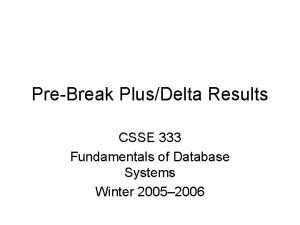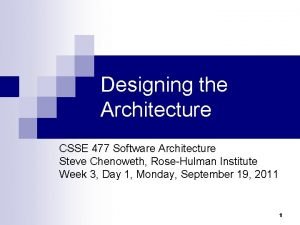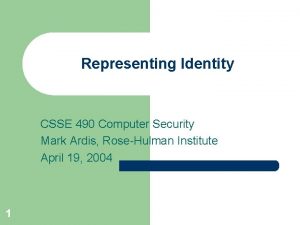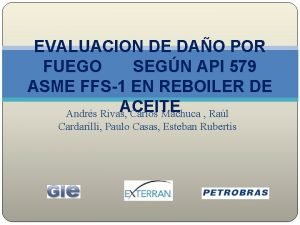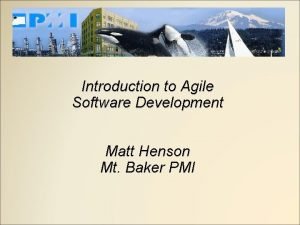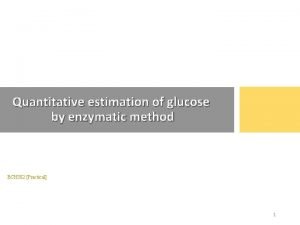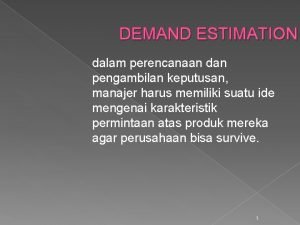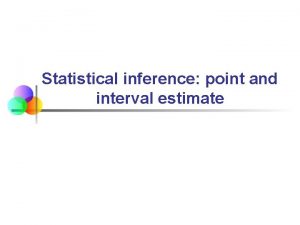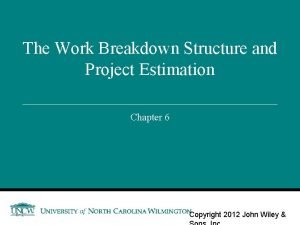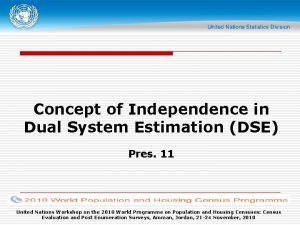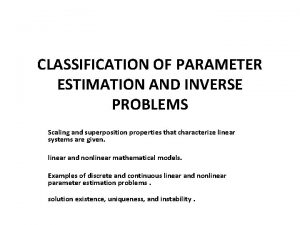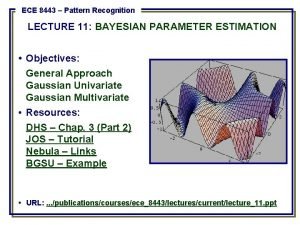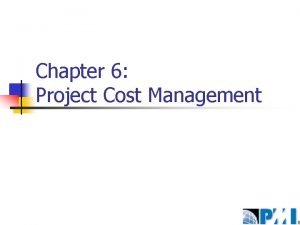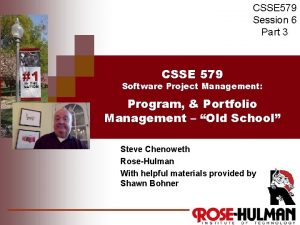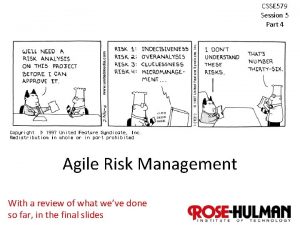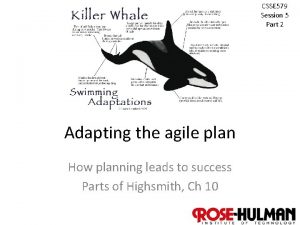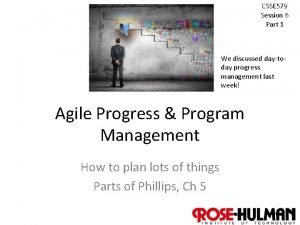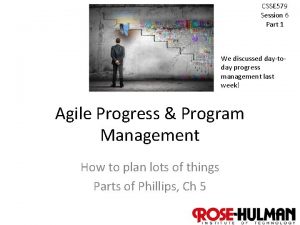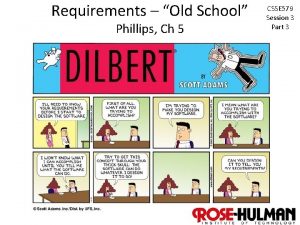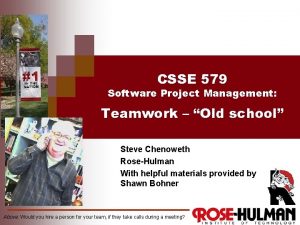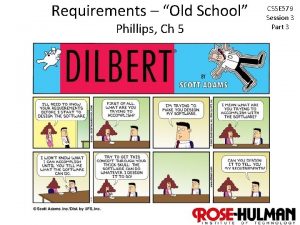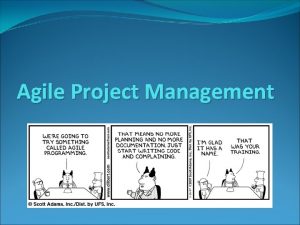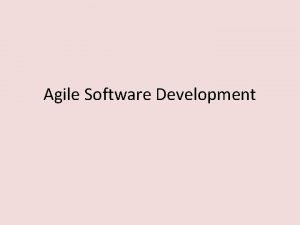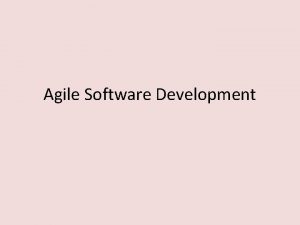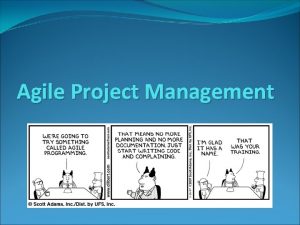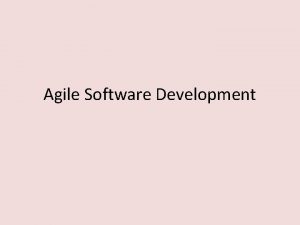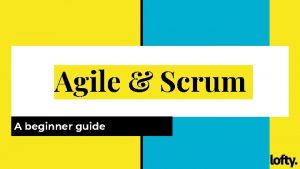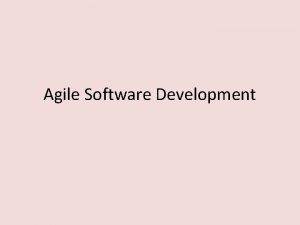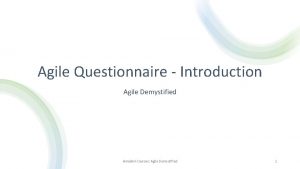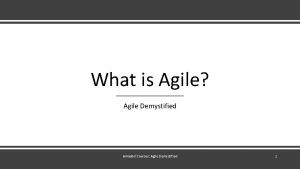Agile Estimation CSSE 579 Session 4 Part 1
























- Slides: 24

Agile Estimation CSSE 579 Session 4 Part 1 Note: Additional questions from the reading quiz – Start on slide 17 1

Week 4’s plan • Jared Goulding is here to discuss our masters program. – And I can propose a summer course – Software Architecture! • • • Exam 1 – Still owe you the key for the objective part. Project/presentation feedback from each person – about project planning. Project planning – requirements, cntd – Week 3, slide set 4 - Agile requirements – Highsmith’s view – we’ll cover a bit more. – At the end of this slide set – respond to a couple of your questions! • • • And we’ll do an activity on creating user stories. And there’s a bit about EVM and Agile there. This week’s topic – Estimation – Week 4, slide set 1 – Agile – Week 4, slide set 2 – “Old school” • Next week – Software risk planning and management – Also, a couple last readings on planning: • • • Day-to-day planning – “Old school” Adapting the plan – in the agile project And – find a Scrum meeting video to report back about! – Next week’s project / presentation assignment has two parts: • • Ask the usual kinds of questions – samples provided Run an estimation experiment on yourself - described 2

Get good at estimating • Classic problem – How much water comes out of the Mississippi River into the Gulf of Mexico each year? • Do it separately. • Write down your calculations and rationale. • Then we’ll compare. 3

One more – same methodology • How many piano tuners work in Terre Haute? – 61, 112 people live here. – There are 2 easy-to-find piano teachers listed. – Indiana State University has a music school with 4 listed piano faculty. – Schools and churches all have pianos, including Rose-Hulman. – Almost every child who takes piano lessons has a piano at home. 4

This is “Delphi” estimating • Experts separately give opinions and explain why. • Then they exchange information. • Goal usually is “convergence” over a few cycles. – Like a consensus • Use when expert opinions are needed to fill-in for a lack of data. 5

How do estimates go wrong? • Step 1: Developers due to pressure or optimism underestimate how long things will take. • Step 2: Bad Problems – Customer apply the pressure to make that schedule. – People get anomic* • Step 3: We remember good things, forget bad things – or the reverse. – There’s definitely some ego involvement in how fast and error-free we can code! – Kahneman’s studies – people only remember highlights of past experience. Feature. Devotion is part of this, too. How? *Sociologist Emile Durkheim’s term. 6

Kahneman and Tversky’s famous studies • Everyone thinks they remember and estimate accurately, but science says otherwise: 7

When should you estimate? Martin Fowler has a specific answer: • Some Examples – 1. Allocation of resources. – Organizations have a mostly fixed amount of money and people, and – Usually there are too many worthwhile things to do. 2. Putting stories into the schedule. – Points versus team velocity 8

Why do it, exactly? Fowler argues that you should never estimate unless you need the estimate to inform a particular decision. • For us, estimation is valuable when it helps you make a significant decision. • If they are going to affect significant decisions then go ahead and make the best estimates you can. Above all be wary of anyone who tells you they are always needed, or never needed. Any arguments about use of estimation always defer to the agile principle that you should decide what are the right techniques for your particular context. 9

“Points” or “ideal days” • • Why are “Points” better than “days/hours”? What did Anand Vishwanath recommend? A relative comparison of stories Both development and testing time Use Fibonacci numbers? Why is this better than using “ideal days”? The real resulting days don’t verify estimates! Points are a relative, abstract scale, like “utility” is used in economics to represent value. 10

Spikes • A place where it’s hard to estimate points. • Can figure backwards – – It’s worth a week for half the team. – So, how many points is that? • Can change later estimates! • Usually the spike is “throwaway” code. 11

Now Points are Bad Too! Stories represent 3 things: • Feature/Function • Richness/usability/depth • Technical complexity 12

Juliano’s burn-up picture 13

Why are we doing this, again? The major problems they want to solve by estimation are: • Derive an estimated scale for a new bucket of stories to help plan future releases. • Provide an estimated effort for each story to help the business prioritize better (from a ROI perspective, value vs. cost) • Synchronize the derived understanding of the story and its context across all distributed locations. • Gain confidence and build customer trust by fully understanding the business/ technical context before commitment to build. 14

People are the fragile part • Reflect on differences and Alistair Cockburn’s discussion of the effect of process… • See IEEE Computer, Nov 2001, http: //www. uml. org. cn/softwareprocess/pdf/IEE EArticle 2 Final 2. pdf • Agile puts more emphasis on people. • A little more process costs you a lot. • Individual strengths are crucial. • People are highly variable and non-linear, with unique success and failure modes. 15

Cockburn’s “Oath of Non-Allegiance” • I promise not to exclude from consideration any idea based on its source, but to consider ideas across schools and heritages in order to find the ones that best suit the current situation. Or, • If you obey all the rules, you miss all the fun. - Katharine Hepburn 16

Additions – from your questions • • Parametric estimation Velocity and acceleration Do a group envisioning activity How to handle customers resistant to agile 17

Additions – Parametric estimation • This is an extension of “using historical data to estimate. ” • Idea is like this: – What are the closest things we’ve done to this new thing we have to estimate? • Except maybe for the size… • Then use relative sizes as a multiplier for your guess. • There’s a lot more to it! – See next slide for one example. 18

Additions – Parametric estimation, cntd “n a typical cycle, you first estimate volume using any of several metrics. Then, feed these numbers to coefficient-driven equations to create a baseline estimate. Adjust this estimate first to your specific project, and then for inefficiencies caused by schedule pressure. Now you can output cost, staffing and risk breakdowns. ” 19

Additions – Velocity and acceleration • In agile developments using points, you decide how long things will take based on experience. – Can start by using previous projects. – Later, you have a basis in the current project. – “How do points equate to expected time? ” • Like points per iteration (or stories per iteration). – This leads to guesses about both: • How much can we get done in the next sprint? And, • How long will the whole project take? – That’s your “velocity. ” – Acceleration – see next slide. 20

Additions – Velocity and acceleration, cntd • What’s acceleration? • It’s changes in the velocity, just like in physics. • Like, “In the last project, we did 5 stories per iteration. In this project, we’re averaging 6 so far. So, we’ve accelerated by 1 story per iteration. ” • In both these measures, clearly the project, team size, and team composition play a role. 21

Additions – Group envisioning activity • (We did one the first week – the bear repellant!} • We’ll do this Friday, April 10. Make that April 17! – We’ll pick a product topic, break into teams. – We’ll design a “product vision box, ” like on Highsmith’s pp 96 -7. • Product name, a graphic. • 3 -4 key bullet points on the front that “sell” the product. • A detailed feature description on the back, and operating requirements. – See example, next page. 22

Additions – Group envisioning activity, cntd - Example 23

Additions – Handling customers who are resistant to agile • They already have a process, which they’ve used successfully. • It’s not agile. • They expect the same “process deliverables” as they’ve always gotten, during development. – Like detailed estimates, EVM reports, risk reports, and documents at completion of stages. – Typical strategy – Try to wean them off these a bit at a time, gaining their cooperation for Agile. – And deliver the benefits of Agile to create enthusiasm. 24
 Csse exam
Csse exam Csse results
Csse results Csse quiz server
Csse quiz server Representing identity in information security
Representing identity in information security Usaid ads 579
Usaid ads 579 Api 579
Api 579 Agile approach to documentation is
Agile approach to documentation is Part to part variation
Part to part variation Part by part technical description example
Part by part technical description example Addition symbol
Addition symbol Footed ware glassware
Footed ware glassware Unit ratio definition
Unit ratio definition The phase of the moon you see depends on ______.
The phase of the moon you see depends on ______. Brainpop ratios
Brainpop ratios Estimation of degradation function
Estimation of degradation function Spray dryer cost estimation
Spray dryer cost estimation Quantitative estimation of glucose
Quantitative estimation of glucose Demand estimation
Demand estimation Structural steel fabrication cost estimation xls
Structural steel fabrication cost estimation xls Point estimation
Point estimation Work breakdown structure test estimation technique
Work breakdown structure test estimation technique Dual system estimation
Dual system estimation Parameter estimation and inverse problems
Parameter estimation and inverse problems Bayesian parameter estimation in pattern recognition
Bayesian parameter estimation in pattern recognition Objectives of cost management
Objectives of cost management

